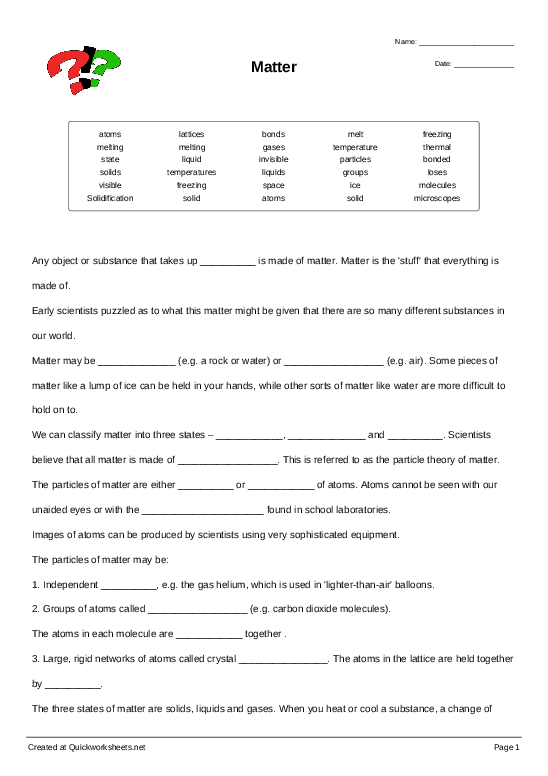Matter
Cloze Test Worksheet
Kindly Shared By:
Date Shared: 27 June 2022
Worksheet Type:
Tags Describing Content or Audience:
Worksheet Instructions:
None provided.
Target Language or Knowledge:
Any object or substance that takes up space is made of matter. Matter is the ‘stuff’ that everything is made of.
Early scientists puzzled as to what this matter might be given that there are so many different substances in our world.
Matter may be visible (e.g. a rock or water) or invisible (e.g. air). Some pieces of matter like a lump of ice can be held in your hands, while other sorts of matter like water are more difficult to hold on to.
We can classify matter into three states – solids, liquids and gases. Scientists believe that all matter is made of particles. This is referred to as the particle theory of matter.
The particles of matter are either atoms or groups of atoms. Atoms cannot be seen with our unaided eyes or with the microscopes found in school laboratories.
Images of atoms can be produced by scientists using very sophisticated equipment.
The particles of matter may be:
1. Independent atoms, e.g. the gas helium, which is used in ‘lighter-than-air’ balloons.
2. Groups of atoms called molecules (e.g. carbon dioxide molecules).
The atoms in each molecule are bonded together .
3. Large, rigid networks of atoms called crystal lattices. The atoms in the lattice are held together by bonds.
The three states of matter are solids, liquids and gases. When you heat or cool a substance, a change of state may occur.
These changes of state occur at fixed temperatures unique to the substance involved.
When a substance is changing state, the temperature stays constant. If enough thermal energy is added to a solid it will start to melt. Melting is the change of state from a solid to a liquid.
The temperature at which the solid substance melts is called its melting point (MP). The melting point of ice is 0°C.
If a liquid loses enough thermal energy it will turn into a solid. Solidification or freezing is the change of state from a liquid to a solid.
The temperature at which a liquid becomes a solid is called its freezing point (FP).
The temperature at which a substance freezes is the same as its melting point temperature. The freezing point of water is 0°C.
space visible invisible solids liquids gases particles atoms groups microscopes atoms molecules bonded lattices bonds state temperatures temperature thermal melt solid liquid melting ice loses solid Solidification freezing melting freezing
Discussion Be the first to comment about this worksheet.
Please log in to post a comment.


Premium Download
You can download this worksheet by purchasing a plan.
It's easy and it's great value!
Already have a paid account?
To claim that this member-shared worksheet infringes upon your copyright please read these instructions on submitting a takedown request.


 Continue with Facebook
Continue with Facebook
 Continue with Google
Continue with Google


27 June 2022
crillstone Author